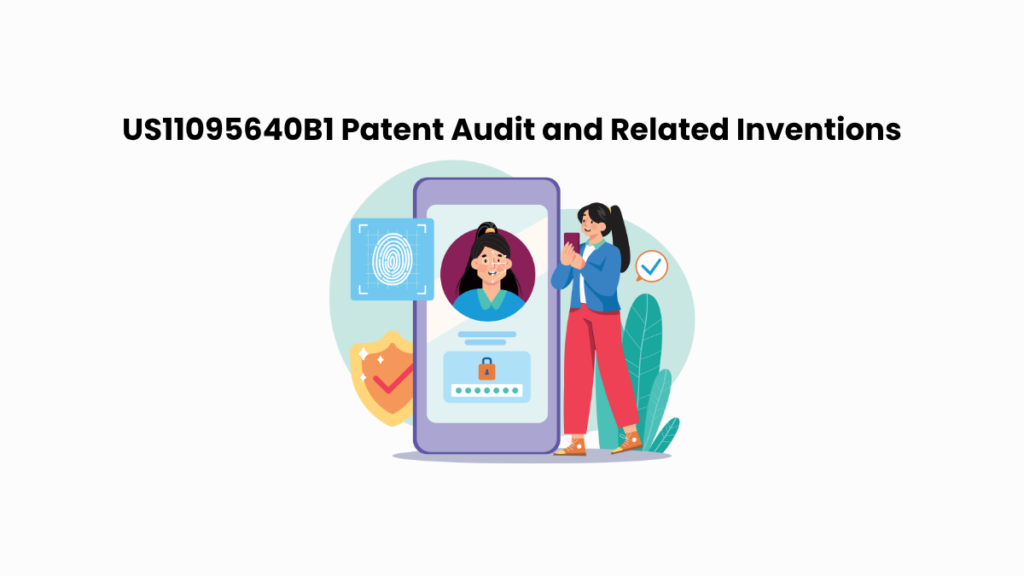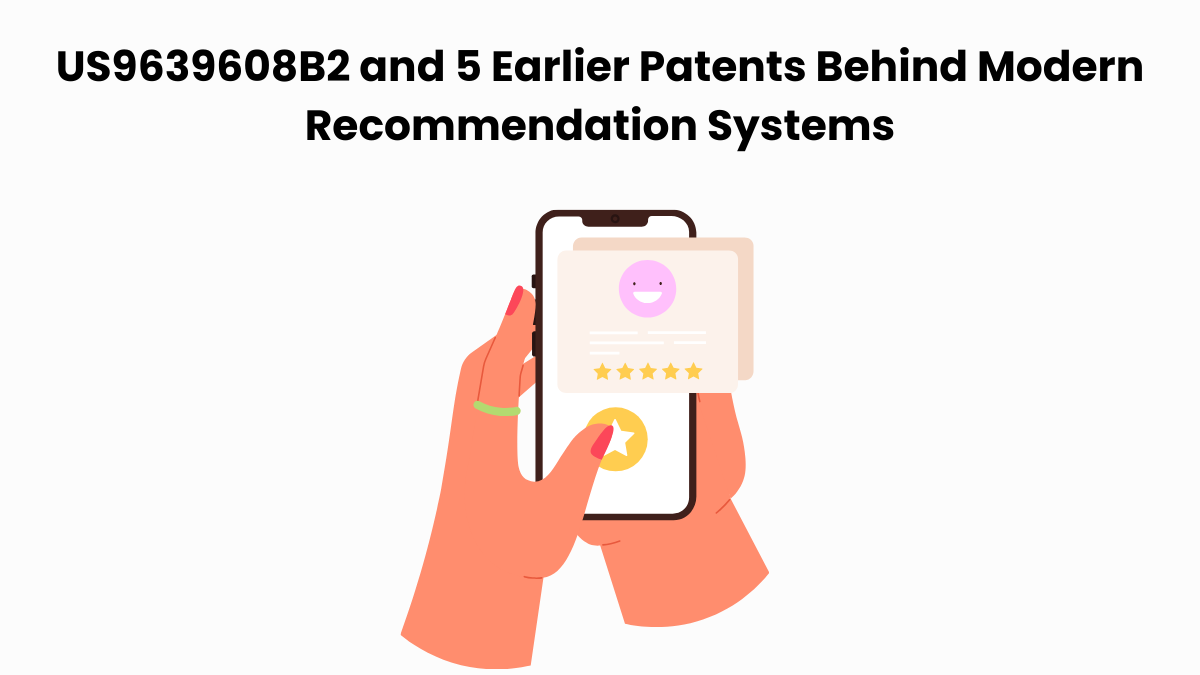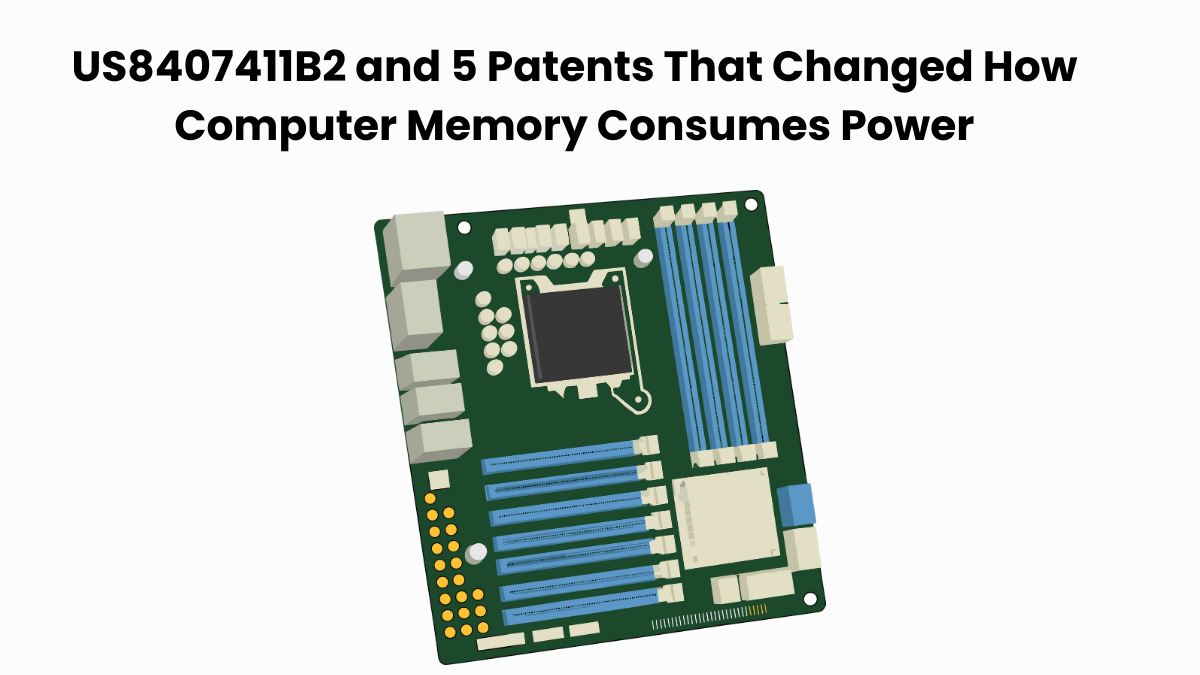Technology that knows who you are and what you need, before you even ask, is no longer science fiction. US11095640B1, assigned to Proxense LLC, is one such patent.
It describes a proximity-based system that utilizes a portable device called a Personal Digital Key (PDK). This device enables secure, automatic access to applications or data, combining biometric authentication with wireless identification to streamline user interaction with connected systems.
In this article, we use the Global Patent Search (GPS) tool to investigate related innovations. We won’t focus on legal issues. Instead, we’ll explore similar ideas like wireless access, secure logins, and identity-based automation.
If you work in IP strategy, product development, or competitive research, this data-driven review offers valuable insights into a growing area of technology.
Understanding Patent US11095640B1
US11095640B1 describes a proximity-based authentication system that automates secure access to data or applications. At the core of the system is a Personal Digital Key (PDK), a portable device that stores user-specific profiles, including biometric data. When brought near a compatible reader, the PDK transmits encrypted identification data. This enables computing devices to verify the user and automatically launch relevant software or services, particularly in environments requiring high security and efficiency.
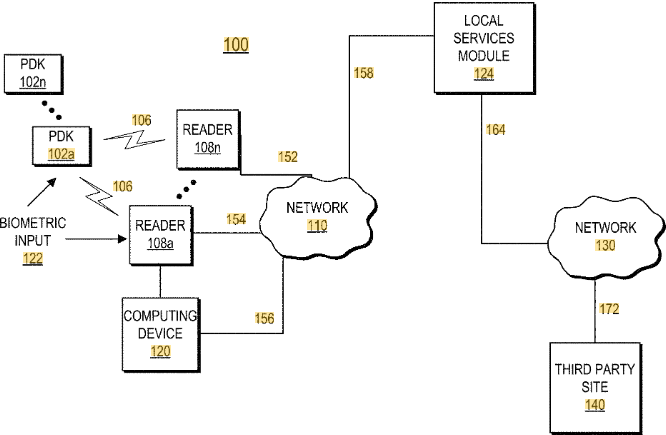
Source: Google Patents
Its Four Key Features Are
#1. Personal Digital Key (PDK): A portable, wireless device that contains biometric and identification profiles uniquely tied to a specific user.
#2. Secure wireless transmission: The PDK transmits identity and authentication data over a secure wireless channel to a nearby reader.
#3. Biometric authentication: The system verifies the user using biometric inputs, such as fingerprints, iris scans, or facial recognition, before granting access.
#4. Auto-login and auto-logout triggers: The system automatically logs users into or out of applications based on proximity, timing intervals, and biometric validity.
This patent is especially relevant for sectors where secure and frictionless user authentication is critical, like healthcare, enterprise IT systems, and safe facility management. See this audit of US9251332B2 for a related approach in wireless access control systems.
The innovation streamlines workflow by reducing the need for manual logins, while maintaining data privacy through localized biometric storage on the PDK. Its architecture reflects a broader shift toward context-aware, proximity-triggered access systems in modern security solutions.
Did you know? Proximity-Based Authentication Patents manage control via spatial triggers, complementing US8533326B2 and similar patents, server-command configuration of devices through contextual automation.
Similar Patents As US11095640B1
To explore the innovation landscape surrounding US11095640B1, we ran the patent through the Global Patent Search tool. Below is a quick glimpse of the GPS tool in action:
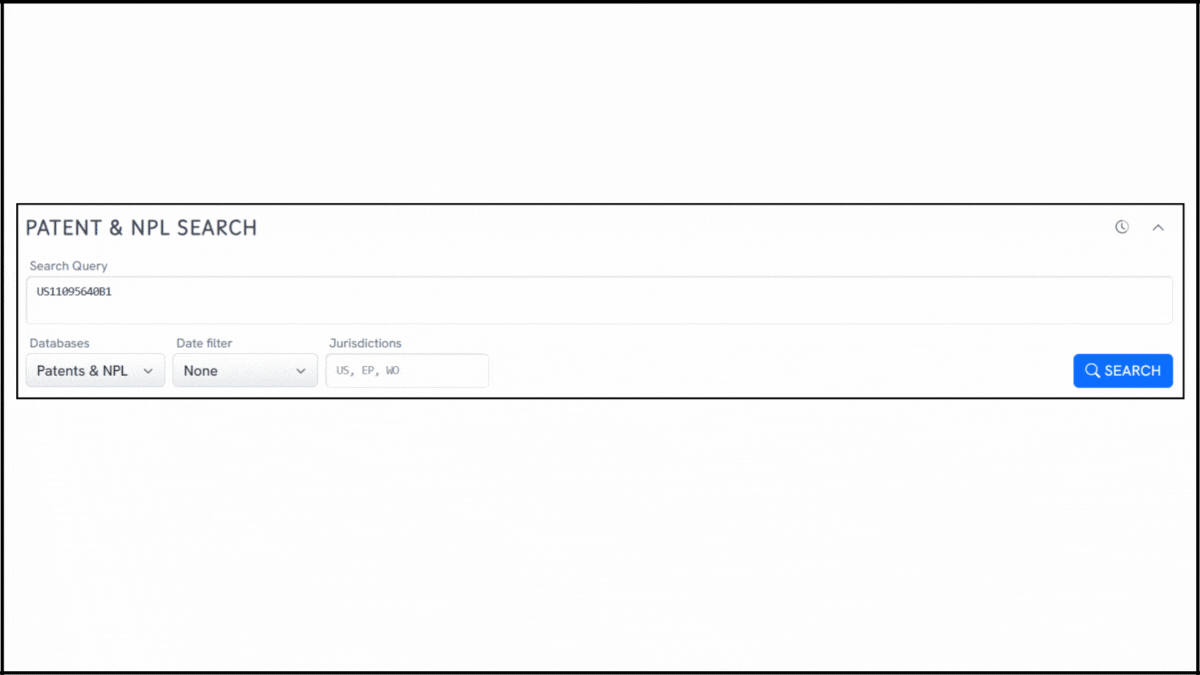
Source: Global Patent Search
This analysis surfaced a list of related patents that share technical similarities in proximity-based authentication, biometric validation, and automatic data access. Below, we highlight five of these references that reflect comparable ideas in secure identification and workflow automation.
A notable match is US9450956B1’s proximity authentication system, which also centers on automatic identity validation triggered by physical proximity. These examples offer insight into how similar challenges have been addressed across different systems.
#1. US20090206992A1
This US patent application, US20090206992A1, was published in 2009. It introduces a healthcare-focused system using a Personal Digital Key (PDK) for secure, proximity-based access to private data. It supports dynamic login procedures based on biometric verification and contextual need.
Below, we have added snapshots from the GPS tool highlighting the relevant snippets from the specification for the similar patents.

What This Patent Introduces To The Landscape
- Biometric profile comparison: A reader matches live biometric input with data stored on the PDK to validate identity.
- Auto login server modules: Includes biometric authentication, access control, and data retrieval components.
- Context-based access control: Sensitive procedures require biometric input, while routine actions may be exempt from it.
- Trusted initialization and registration: PDKs are tied to a secure enrollment process with device and profile registration.
How It Connects To US11095640B1
- Shares a nearly identical system design using wireless PDKs and secure biometric matching.
- Emphasizes context-aware, user-specific access protocols.
- Aligns with the original patent’s focus on healthcare system integration and automatic login.
Why This Matters
This reference demonstrates that biometric-enabled, proximity-based login systems have long been explored in healthcare. It reinforces the core concepts of US11095640B1 by showing precedent for secure access models built around portable digital credentials and automated workflows.
#2. US20180019998A1
This US patent application, US20180019998A1, was published in 2018. It describes a system that uses a Personal Digital Key (PDK) to facilitate secure, automatic access to applications or data. The system supports biometric authentication and includes provisions for time-based access control, initialization by a trusted Notary, and user tracking across computing environments.
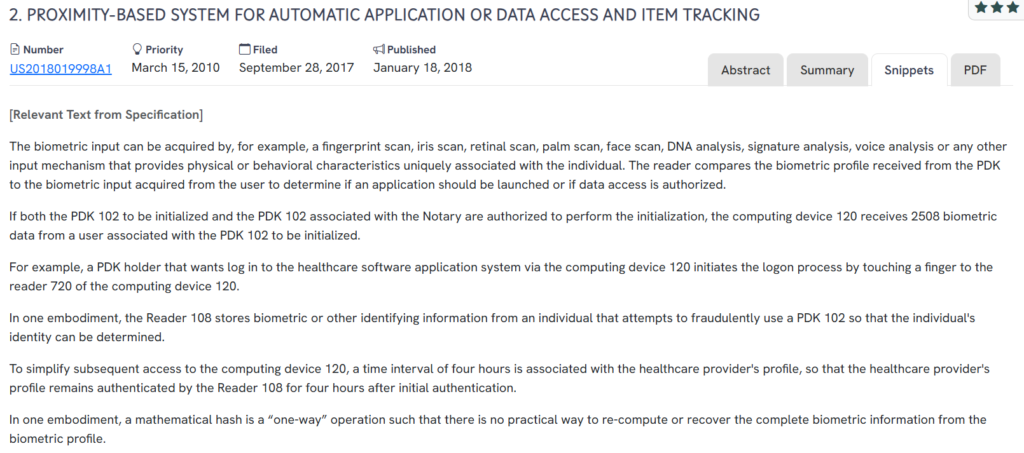
What This Patent Introduces To The Landscape
- Multi-factor authentication logic: The system compares biometric inputs from the user to encrypted profiles stored on the PDK to grant access.
- Trusted initialization: Biometric data must be enrolled via an audited process with dual authorization from a user and a Notary.
- Time-bound session management: Authenticated users can remain logged in for predefined intervals without requiring repeated biometric input.
- Proximity-triggered auto login: Entry into a reader’s proximity zone triggers automated authentication and application launch.
How It Connects To US11095640B1
- Both patents use PDK-based proximity systems with integrated biometric profile matching.
- Each describes auto login features initiated by secure wireless communication.
- Both target healthcare environments with context-sensitive access protocols and secure login automation.
Why This Matters
This reference strengthens the technical foundation behind US11095640B1 by illustrating a nearly identical framework. It supports the growing role of proximity, time-based logic, and trusted authentication layers in automating secure access, especially within critical, data-sensitive environments like healthcare.
#3. US20020138767A1
This US patent application, US20020138767A1, was published in 2002. It outlines a system where a portable biometric device enables secure access by matching biometric data to predesignated access points. The device uses encoded biometric descriptions and wireless transmission to authorize user-specific entry across multiple portals or services.
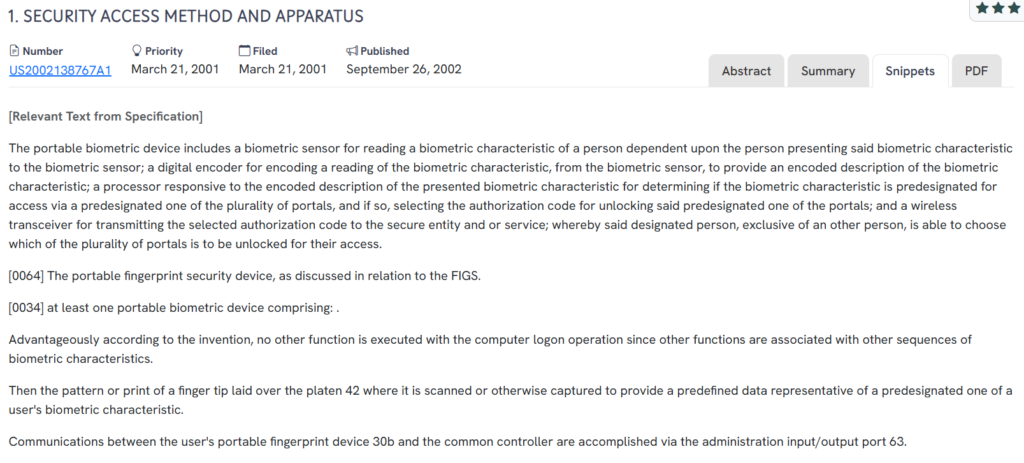
What This Patent Introduces To The Landscape
- Encoded biometric authentication: A biometric sensor captures a characteristic (like a fingerprint), which is then digitally encoded for processing.
- User-driven access targeting: The user selects which portal or secure service to access, based on a predefined biometric match.
- Wireless transmission of authorization codes: Once matched, the device transmits access credentials wirelessly to the target system.
- Role-based portal differentiation: Each biometric input corresponds to a different level or type of access, allowing fine-grained control.
How It Connects To US11095640B1
- Uses a portable biometric device to control and automate secure access.
- Relies on biometric matching to trigger access authorization through wireless communication.
- Emphasizes user-specific identity management for access to secure systems or services.
Why This Matters
This reference shows how early biometric devices laid the groundwork for modern proximity-based systems. It highlights concepts like role-based access, portable credentials, and biometric-driven control, principles that align closely with the functionality outlined in US11095640B1.
#4. US20070253601A1
This US patent application, US20070253601A1, was published in 2007. It describes a system for biometric verification using dynamic encryption to capture, transmit, and validate an individual’s biometric features through secure access points connected to a centralized server.
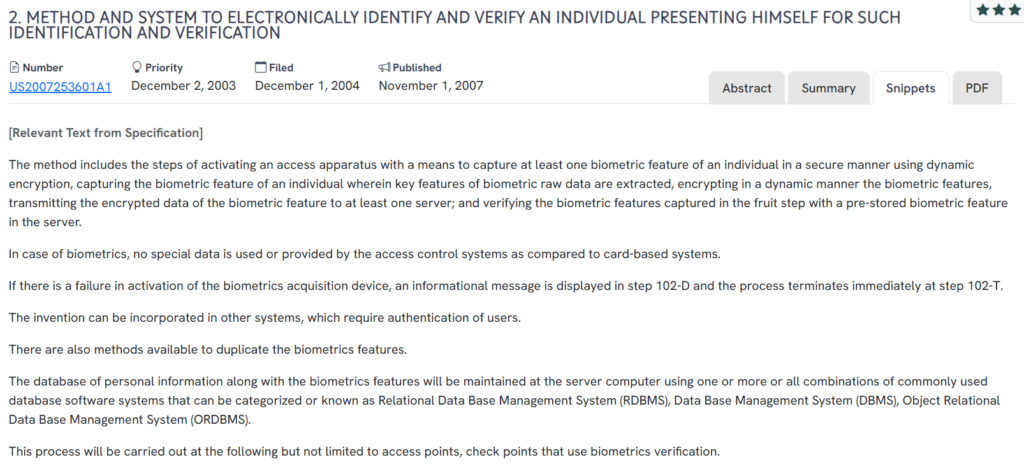
What This Patent Introduces To The Landscape
- Dynamic biometric encryption: Biometric data is encrypted at the time of capture before being transmitted to a server for validation.
- Server-side verification: The system matches live biometric data with pre-stored features housed in a remote database.
- Access point integration: Designed for use at checkpoints and secure entry points where user identity must be confirmed.
- Fallback and failure messaging: Includes error handling processes for failed biometric captures or device malfunctions.
How It Connects To US11095640B1
- Both use biometric features as the primary mechanism for identity verification.
- Each supports secure communication between local devices and authentication servers.
- Both systems focus on enabling access control based on verified personal identity.
Why This Matters
This patent reinforces the importance of biometric verification systems that protect user data in transit and at rest. It offers an early example of centralized biometric authentication, which complements the local device-based strategy seen in US11095640B1, enriching the broader context of identity-based access innovation.
Recommended read: If you’re exploring how mechanical stress causes long-term failures inside electronic components, this analysis of US8258611B2 shows how a redesigned leadframe stops delamination at the chip-package interface.
#5. WO0036566A1
This international patent application, WO0036566A1, was published in 2000. It introduces a biometric identification system that emphasizes secure handling of biometric data through token-based devices. The core focus is on preventing data compromise by ensuring that biometric inputs are used only for internal decryption and are never externally transmitted or stored in reusable form.
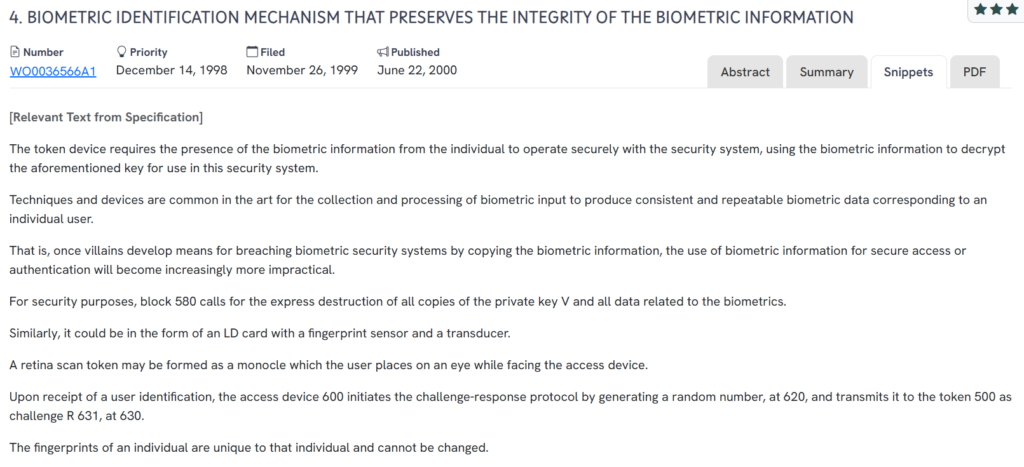
What This Patent Introduces To The Landscape
- Token-based biometric verification: A portable device uses live biometric input to decrypt access credentials stored securely within the token.
- Biometric-protected key usage: The biometric information decrypts a private key that is then used in a challenge-response protocol with the access system.
- Biometric data containment: No raw biometric data is transmitted or stored externally, minimizing exposure to interception or duplication.
- Data integrity by design: All copies of biometric-related data and cryptographic keys are explicitly destroyed after use.
How It Connects To US11095640B1
- Both systems rely on biometric input to unlock secure functions or credentials stored on a portable device.
- Each approach values the containment of sensitive data within the user’s control to enhance trust and privacy.
- Both use proximity-based logic to trigger access validation using user-held authentication hardware.
Why This Matters
This early work on tokenized biometric security underscores the long-standing need to protect biometric data from external exposure. Its emphasis on privacy-preserving architecture mirrors the design intentions of US11095640B1, offering a foundational view into secure, user-centric identity systems.
How To Find Related Patents Using Global Patent Search
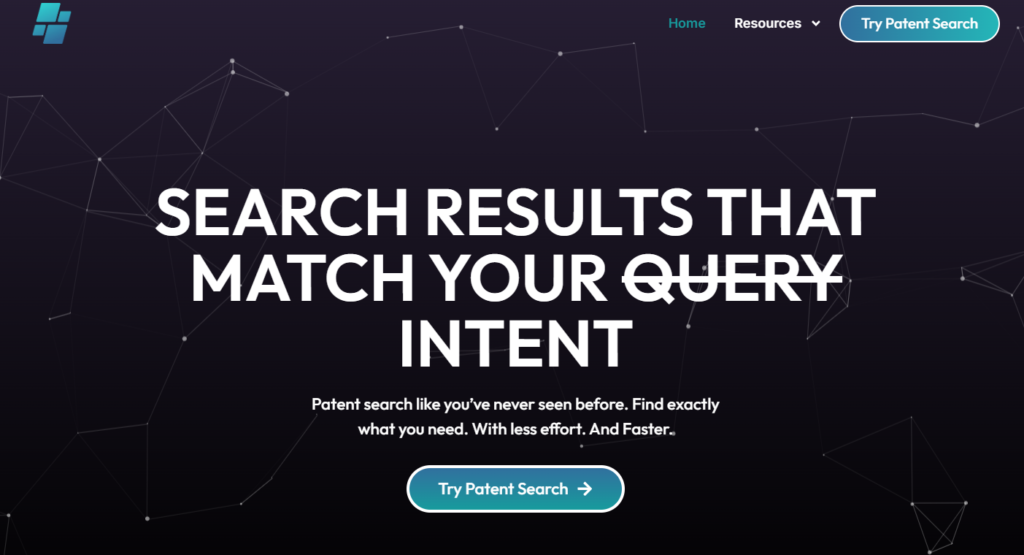
Understanding the broader patent landscape is key when exploring innovations in biometric security, automatic login systems, or proximity-based authentication. The Global Patent Search tool streamlines this process, helping users discover systems that mirror similar access control models or personal identification workflows.
1. Enter the patent number into GPS: Start by entering a patent number like US11095640B1 into the GPS tool. The platform transforms it into a smart query, which you can refine using terms like biometric authentication, PDK, or proximity access.

2. Explore conceptual snippets: Instead of comparing features claim-by-claim, GPS now delivers curated text snippets. These highlight how other inventions handle secure login, user verification, or device-triggered application access.
3. Identify related inventions: The tool reveals patents that address similar challenges, like portable credentials, server-based authentication, or role-based access control, showing how others have tackled trust, automation, and security.
4. Compare systems, not legal claims: Rather than focusing on legal phrasing, GPS compares how systems behave in practice. This helps users connect inventions based on how they function, not just how they’re written.
5. Accelerate cross-domain insights: Whether you’re working in healthcare IT, cybersecurity, or digital identity, GPS lets you uncover related solutions across fields that may otherwise be overlooked. For instance, US7177838B1 explores secure token-based identification using digital credentials in healthcare and enterprise contexts.
With this approach, Global Patent Search provides inventors, analysts, and legal teams with a structured, concept-driven method for investigating related patents and developing more informed IP strategies.
Disclaimer: The information provided in this article is for informational purposes only and should not be considered legal advice. The related patent references mentioned are preliminary results from the Global Patent Search tool and do not guarantee legal significance. For a comprehensive related patent analysis, we recommend conducting a detailed search using GPS or consulting a patent attorney.

